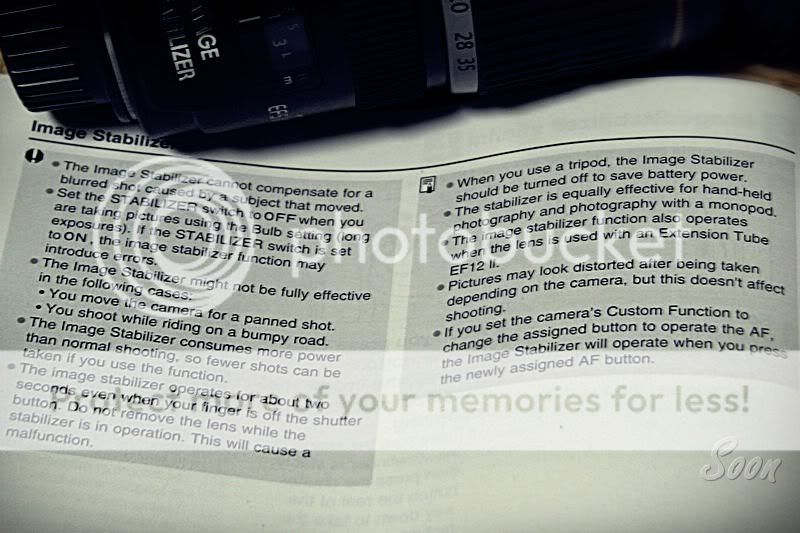Is there any effect if IS/VR is turned on even if you don't need it (pic quality, battery consumption, etc.)?
Why do you have to turn off IS/VR?
- Thread starter thinslicing
- Start date
You are using an out of date browser. It may not display this or other websites correctly.
You should upgrade or use an alternative browser.
You should upgrade or use an alternative browser.
- Status
- Not open for further replies.
Is there any effect if IS/VR is turned on even if you don't need it (pic quality, battery consumption, etc.)?
You have to turn it off when your camera is mounted on a tripod.
IS/VR takes up battery fr your camera when your shutter is half-clicked/ you hear the buzzing sound. Incidentally, i also read that you should turn off IS/VR before dismounting your lens to stop the bits inside from shaking around in the lens... but im always too lazy to do it.
yeah, like isisaxon said, when on tripod it will make your photos blur
yeah, like isisaxon said, when on tripod it will make your photos blur
Entropy_H in Thread ID No. 407059 (2008.08.21):
"Do you think VR man could eliminate handshake blur at extremely slow shutter speeds even without using lenses or bodies with VR/IS/etc ?". :bsmilie:
"Do you think VR man could eliminate handshake blur at extremely slow shutter speeds even without using lenses or bodies with VR/IS/etc ?". :bsmilie:
depends on what tripod you're having also... those days i got very shaky tripod... didn't notice because i was using VR lens switched on all the time... the photos were hella sharp... then i thought it was just bullshit...
after a while i bought 50mm prime, no VR... mounted on tripod and found that most photos are blur like hell...
then only i know VR has been working perfectly on the tripod... :cry:
after a while i bought 50mm prime, no VR... mounted on tripod and found that most photos are blur like hell...
then only i know VR has been working perfectly on the tripod... :cry:
Because the IS would get tired if left on permanently? :bsmilie:
[vid]_dPlkFPowCc&feature=player_embedded[/vid]
http://www.youtube.com/watch?v=_dPlkFPowCc&feature=player_embedded
[vid]_dPlkFPowCc&feature=player_embedded[/vid]
http://www.youtube.com/watch?v=_dPlkFPowCc&feature=player_embedded
You have to turn it off when your camera is mounted on a tripod.
May I know why?
May I know why?
in my simple understanding n laymen terms, the VR works by generating vibrations to counter the shake when we hand hold our camera. so when on tripod when the camera should be stable n shake free, the VR will be counter productive n result in blury images
usually off it when I shoot in bright daylight when I know shutter speed is high enough to prevent handshake
but usually on it in low light / night shooting when the shutter speed drops and I need the VR
conserve battery
but usually on it in low light / night shooting when the shutter speed drops and I need the VR
conserve battery
For the reasons already mentioned (battery, safety when detaching, tripod), and importantly when you are shooting anything action oriented and are not panning.
May I know why?
When you're handholding the camera, the vibration frequency is low. When you fix the camera on a tripod, the vibration frequency is quite high and the VR may not be able to keep up and would be able to correct and make it worse.
When you're handholding the camera, the vibration frequency is low. When you fix the camera on a tripod, the vibration frequency is quite high and the VR may not be able to keep up and would be able to correct and make it worse.
You mean the vibration created when we are putting the camera on a tripod will affect VR function?
Last edited:
Image Stabilization (and vibration reduction) lenses look for vibrations in your camera in order to reduce it - however if they dont find any (like when you are using a Tripod) they actually can cause it - and as a result actually cause camera shake.
May I know why?
Here is Scott Kelby's explanation from his book "The Digital Photography book - Step by Step Guide- How to make your photos Lok like the Pros"
"The non-technical explanation why is, these VR lenses look for vibration. If they don't find any, they'll go looking for it, and that looking for vibration when there is absolutely none can cause (you guessed it) some small vibration."
HTH

Like many said, when there is no absolute shake on a tripod, the image stablizer/ Vibration Reduction will attempt to look for shake. The IS/VR element will move everytime when VR/IS is enabled. That element will over-correct when there is no absolute shake when mounting on a tripod.
Last edited:
Apparently some of Nikon's VR lenses are designed to be used on tripods specifically to counter motion blur caused by mirror slap, etc. News to me and I have no idea if it works.
There are exception to the rule. In the case of IS it is important to know that there are some DSLR lenses that can actually sense and account for when youre using a tripod. As a result you dont need to switch image stabilization off at all.
Read your lens manual and you wont go wrong.
Read your lens manual and you wont go wrong.
- Status
- Not open for further replies.
Similar threads
- Replies
- 0
- Views
- 269
- Replies
- 0
- Views
- 94
- Replies
- 0
- Views
- 87
- Replies
- 0
- Views
- 173
- Replies
- 0
- Views
- 149


